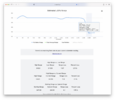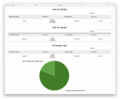I would like to see very clear scientific crowd sourced data on this. Few people keep keep charging below 55% on an ongoing basis and yet have about 5%-10% degradation after 100K miles.
There is a huge thread (or more than one) on the model 3 battery subforum that's lasted a few years. Member AAKEE is the definitive analyst of the research literature, and personally conducts some scientific tests. The source is from controlled battery research tests from scientific labs which consistently show the same phenomenon on calendar aging.
I've had my car, performance model 3, for about a year and a half now, daily driven about 20-45 miles, always starting at 90%, going down to 70-75% each night. Only ever road tripped once, from michigan to florida which was about 3000 miles of supercharging, home charging for the rest. Michigan...

teslamotorsclub.com
That depends purely on time, state of charge, and temperature (temperature is a major effect too). Those are not controlled in people's reported use in field so it's difficult to see the pattern, but the phenomenon is real and built into the chemical facts. The calendar degradation rate is pretty flat between 60%-100%, but about 2x as high as 50% or below (this has to do with some complex chemical stuff happening at electrodes vs voltage). Some research reports, but not others, show a dip so that 80% is a bit worse than 70% or 90% for calendar aging. That's still unclear, but if it were me and I needed a higher upper charge limit than 50%, I would avoid around 80% and choose higher or lower for the car to sit at for a while.
Cyclic degradation (from charging) is separated from calendar degradation (from time) scientifically.
For most people, unless they drive commercially long distances all the time, calendar degradation is more significant than cyclic degradation. Though research results also suggest that shallow cycling at low state of charge is also better to lower degradation.
Myself personally my charge limit is 50% unless I need to make long trips, in which case I charge it up to 95-100%. I've done this since I've owned the car, nearly exactly 1 year now. My degradation (though BMS calibration makes this inaccurate) is about 2.7% (10/358 miles). Calendar degradation goes as sqrt(time) so in 4 years its 2*2.7 and 16 years it's 4 * 2.7 about. If I had charged up to 80% like most people and had it sit around there most of the time (common), it would be about 5-6% which is typical experience.
Also, with summer here or coming (still cool in san diego, we get summer late), lowering the average state of charge is more important when average battery temperatures are higher. The degradation rate multiplies, like many chemical reactions.
There are folks with 130K to 369K miles showing off their cars and typical degradation reported maxes out somewhere around 10%, typically. Tesla published a report here, where Model S long term degradation after 200K miles is 12%.
Miles is not the same as time, which is the effect I'm talking about where being under 55% is distinctly better (there is a shelf in calendar degradation rate about there in NCA batteries). A car whose batteries are not that old and experiences more cold will degrade less than a car whose batteries are older and in hotter temperatures.
Overall Tesla has good battery management, and most people's experience with degradation is not poor, unlike the air cooled Nissan Leaf. (BTW that shows the huge effect of temperature on calendar aging rates.). Average public behavior will get decent results.
People who read forums here though are more of the committed nerd types, and they can handle the science facts to optimize it even better. I'm thinking about what happens after 8 years. At that point different management and charging procedures will start to show different results, many will have 15-20% degradation, and I hope to have 10% or less (7.5% calendar 2.5% cyclic?). That will eventually make a difference in resale value. People with typical charging procedures will have 15% calendar and maybe 3% cyclic.
In practical use, people who drive more also tend to have a lower average state of charge, as the car spends more time being discharged off its maximum. That helps calendar aging if the car spends much of its time below 50% because it was previously driven that day. That obscures the effect of calendar vs cyclic aging and people see low degradation even though they drive frequently with their new car.
Somewhat unexpectedly, the people who fastidiously recharge up to 80% and don't drive much, thinking they are 'babying' the car, will have the worst results on battery aging.
Perhaps this is due to the 200K miles and all the cycles vs SOC being higher than 55%? Age is what Tesla's notes cite.
Here is the report page 39.
https://www.tesla.com/ns_videos/2022-tesla-impact-report-highlights.pdf
The Note on that page mentions that 'mileage is only one factor in battery capacity retention; battery age is also a major factor'.
A 200K 4 year old car will have less aging than a 200K mile 10 year old car. People are used to miles being the primary determinant of degradation from experience with ICE cars. Though even with ICE cars the right metric is probably hours in use, but that is not measured anywhere. For EVs, time itself matters the most, and the conditions of storage are not something that people are used to thinking about very much, even though that matters the most for the battery cells.




